Interviews / Artists’ movies
John Smith: Of process and puns
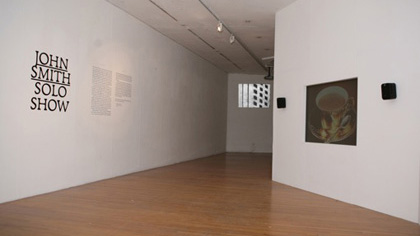
The entrance to John Smith’s solo show at the RCA. Photo: Lauren Winsor
John Smith makes the mundane strange and the avant-garde funny. With three new works on show at his largest ever UK retrospective, he talks to Nick Bradshaw about his special brand of trompe l’oeil Brechtianism
For anyone labouring under the impression that experimental movies are invariably arid exercises in academic formalism, John Smith’s films and videos come as a great spritzer. Lifelong card-carrying structuralist-materialist he may be – his works want you to notice their physical or, more often, linguistic construction – but they typically do so by teasing and subverting narrative rather than rejecting it out of hand. They’re also delightfully funny, using humour to play up the different meanings of an image, or more and less accustomed ways of seeing. His most famous film, The Girl Chewing Gum (1976; distributed on the British Cinema 16 DVD), presents Dalston street footage as rushes directed by an audible, increasingly megalomaniac director; The Waste Land (1999) finds the film-maker himself reciting TS Eliot in the bogs of his local boozer. (Only Smith could see poetry in the reflection of a loo-door sign.)
To put it another way, he’s an arch proponent of puns. Om (1986) conflates stereotypes of a chanting Eastern mystic and East End bovver boy. Associations (1975) features a dry reading from Herbert H. Clark’s Word Associations and Linguistic Theory flickeringly illustrated / counterpointed by static images of homonyms for the words being read (the film’s title, for instance, is visualised as an ass, a sewing machine, the sea and a group of Asian girls); the comedy of the piece is in trying to keep up with Smith’s increasingly rapid-fire, off-the-wall wordplay.
Smith has said that The Girl Chewing Gum was inspired by proposed stop-and-search laws which would empower the police’s prejudicial worldview, but over the years the politics of his pieces have become franker, much as he has increasingly used himself as a character and subject in his films. Home Suite (1993-94) explores the memories conjured by his own East London home as he was being evicted to make way for the M11 Link Road (a devastation further explored in the beautiful protest musical Blight (1996)); his Hotel Diaries (2001-07) is a series of startlingly unadorned single-shot video monologues, in which the film-maker, camcorder in hand as he sits in hotel rooms around the world, finds consistently remarkable ways to relate the microcosms of his surroundings to the ongoing calamities of the Middle East.
Smith graduated from the Royal College of Art in 1977 and has now come full circle, presenting his largest ever UK retrospective under the auspices of the college’s Curating Contemporary Art MA-degree students. Smith used to prefer to cinema screenings to galleries, but the RCA show runs the gamut, incorporating a mix of free-standing 16mm and video projectors, video monitors and dedicated cinema spaces. It includes his first high-definition video piece – Flag Mountain (2010), shot across the divided rooftops of Nicosia in Cyprus – and two new installations which reconfigure older works. Double Shutter takes two of the three sections of 1979’s Blue Bathroom, featuring alternating double exposures (by night and day) of an electric fan and a bathroom ventilator, and screens them on opposite walls, conjuring strange intimations of visual and physical interactions across the room. In Third Attempt, two prior attempts to record Smith singing ‘The 12 Days of Christmas’ across so many days – the 16mm 7P (1978) and standard-def video Regression (1999) – are screened side-by-side, a dialogue across time that encapsulates the exhibition entire.
NB: How does it feel to be bringing everything back to your alma mater after 35-odd years?
JS:Thirty three, since I left. It’s kind of strange. When I was a student the film school was round the back of the Natural History Museum, in a prefab building they used to stuff dead animals in, and I only ever used to go up to the main building to go to the bar, or watch The Clash playing or something. I never knew the gallery space existed until I went along to do this show and found how enormous it was.
I’ve had some intermittent contact with the place over the years since I left, showing my work, doing a couple of tutorials. I hadn’t met this particular group of students on the Curating Contemporary Art course before, but apparently they wanted to do a solo show with somebody, and when they saw The Girl Chewing Gum, that was something they could all agree on.
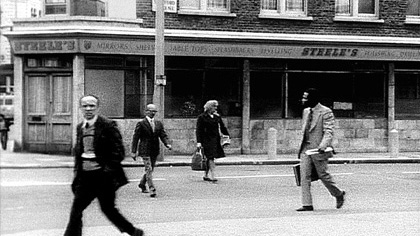
The Girl Chewing Gum (1976)
How do you feel about that film still being your trailer?
I’ve mixed feelings. I find it quite funny, because when I first made that film I thought it was quite interesting, but nobody else did. I remember sending it to the Edinburgh Film Festival and it getting rejected, I guess because it’s a film that deals with film language and formal ideas but is also comic, which at the time was maybe a little problematic in the world I inhabited. I kept showing it for a couple of years before anybody took an interest. Maybe it’s my own fault that it’s now become one of my most popular films; I certainly made it pretty familiar. I still tend to show it in any selection of my work, because it’s a good introduction to ideas about cinema, where I’m coming from, the power of the voiceover, illusionism and all those things.
Of the earlier pieces in the show, The Hut and Leading Light seem to embody the two poles of your interests. There’s a documentary appreciation of the world in Leading Light, and a total mangling of it in The Hut.
That’s true. Most of the work falls between those poles and shifts in and out of naturalism and representation on the one hand and extreme abstractions on the other. Films like The Black Tower are very much to do with the way one can move between illusionistic involvement and awareness of construction, abstraction and representation.
And you’re still doing that today with Flag Mountain.
Well, we only have a few ideas in life, don’t we? That’s the thing about showing a lot of work together; you realise you’re giving away that you have certain motifs through lots of your work. The whole idea of windows by day and by night, that positive and negative aspect which runs from Leading Light to the Double Shutter piece and Flag Mountain, is really recurrent, as is the animation of the real world by matching framings, the pixilation of objects. I have to remind myself that you might see a hundred reworkings by a painter of the same image, because I always want the new work to be something I haven’t done before, and obviously that gets harder as time goes on.
Leading Light reminds me of certain contemplative artists who one wouldn’t normally associate with you – Nathaniel Dorsky, or other American artists who play directly with light on film. Do you feel a part of that conversation across the Atlantic?
Yes, and when I was first making work I was really interested in a lot of the American stuff – the obvious, Michael Snow’s incorporation of narrative elements within the formal structure, and also the humour of a lot of that work. I thought there was a bit more poetry or humour there than in much of the English stuff. I really like the work of some of my contemporaries, but there was quite a lot of rather mechanistic work made in structural filmmaking in Britain. By myself included sometimes, I think.
Was your interest in narrative also seen as deviant in the structuralist world?
I don’t think so. People ask me that question a lot; the work didn’t particularly fit in, but I don’t think people had problems with my work any more than I had with theirs. I just personally had a fascination with narrative, and wanted to have a narrative element in the work. I’ve said it before; I have a love/hate relationship with the power of cinema, so I love that immersion in another world, but I also know it’s kind of naughty, in Brechtian terms.
Failing to demystify?
Yes! It’s very ingrained in me that I have to demystify everything. I wouldn’t be happy if I made work which didn’t draw attention to its construction.
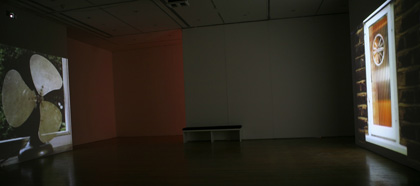
Double Shutter (2010) Photo: Lauren Winsor
Your experiments with process and phasing remind me of Steve Reich’s early music. What’s happening with Double Shutter? It gives the strange sensation of sitting in a light-and-wind tunnel.
I made quite a few films which I don’t show any more which are very process-based, and simple, formal ideas: for example a ten-minute film with a self-explanatory title, Subjective Tick-Tocks (1975), which is just a metronome swinging backwards and forwards for the length of one 400-foot roll of film, with the camera panning backwards and forwards across the metronome in different rhythms. I was interested in how a camera movement might affect your perception of audio rhythms. And when I made The Hut I was interested in perceptual psychology and the perception of visual rhythms – how easy it would be to perceive rhythmic cutting.
Double Shutter is actually really simple in its construction; there’s no editing at all. It’s all single shots, and to do with alternating images, masking the day or the night image. So the piece with the electric fan is simply two superimposed images of a fan by day and by night – with the lights off by day, so it’s silhouetted, and on by night, when the background’s dark. And it’s filmed through another fan, masking the day or the night image. So it’s two parts come together to form a single image – if you took the alternating device away you’d just be looking at a seemingly naturalistic image of a fan in the daytime with the lights on. I also had both fans on a dimmer switch so I could play with their speeds.
Which interact with the camera shutter.
Right, the wagon-wheel effect. So that film’s actually triple-shutter, the camera shutter and the two fans. Whereas the other part, with the bathroom ventilator and the cardboard flag going up, is completely manual; although the image becomes quite complex, it’s literally somebody bringing a piece of cardboard towards the camera until the image is obscured, then walking away again, initially just by day and then the night images comes in, and you get quite complex patterns between the two.
It’s funny, because at the time I made the original film, the audience for artists’ film were basically artist filmmakers, and lots of us were all dealing with related ideas. Nowadays people are always asking “How did you do that?”
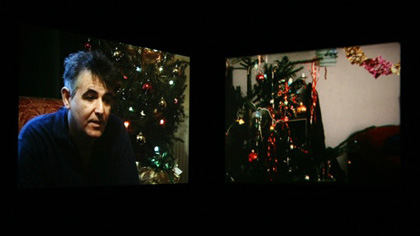
Third Attempt (2010), featuring Regression (left, 1999) and 7P (right, 1978) Photo: Lauren Winsor
Third Attempt, like the whole exhibition, shows some of the things that have been changing in your work over time – one of which is the foregrounding of yourself. Has that become easier?
Absolutely. When I made The Girl Chewing Gum I used my own voice, but couldn’t bear to listen to it – I remember playing around in the RCA dubbing studio trying to disguise it, make myself sound more grown-up. But now it’s been tuned by years of cigarettes and whisky...
I still feel slightly uncomfortable with some of the more confessional aspects of the work, but take a sort of masochistic pleasure in making myself squirm. Particularly in the Hotel Diaries, which are improvised single takes, I’ll say something and think “Fucking hell, that was embarrassing”, but I’m stuck with it. But it’s quite a deliberate device to have that level of mistake in those pieces. I don’t want to be didactic because I’ve got nothing special to say; I’m sure my armchair-socialist opinions are very irritating for a lot of people. I hope the spontaneity makes them less like a lecture; I’m more interested in sharing concerns and cathartically – for myself – ranting... I really like that the Hotel Diaries pieces have given me the opportunity to go around the world and slag off my government’s involvement in Iraq and Afghanistan.
The unedited aspects seems quite radical not only in the context of your earlier works, but also given how heavily processed TV has become.
They’re wilfully simple. I’ve got myself into trouble at film festivals when I’ve won prizes for those films, particularly in Cork when I won the main prize for Museum Piece. I had to make a speech, and I said that it gave me particular pleasure to get a prize for this film because I’m a great believer in economy, and this film cost €7, or the price of one DV tape. And afterwards I had so many really angry young filmmakers coming up to me, saying “I borrowed £10,000 to make my film, and yours is a load of shit!”
What does sometimes upset me if people don’t tune into those pieces is when they ask, “Did you plan what you were going to say, or did you just switch on the camera and wave it around?” Actually, apart from Frozen War, the first piece, which is spontaneous, they’re all planned: I know what I’m going to be looking at when I’m talking about a particular thing, and there are lots of connections between image and sound. But maybe people just don’t get the metaphorical significance of talking about Yasser Arafat having just died while the camera’s looking at an empty bed, those sorts of things.
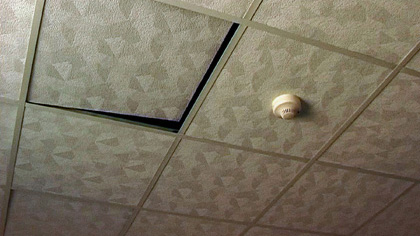
Dirty Pictures (2007), from Hotel Diaries
Again in Third Attempt, you’ve got 16mm and video playing across each other, and you talk about finding video in some ways more useful and convenient. Is that your final judgement?
No, not at all. The reason it’s called Third Attempt is that whereas the film I made in 1978 has those physical qualities of film that I talk about in the video – it’s really raw, the splices move and there’s a lot of grain – after I’d made the video piece I felt it was a bit sanitised, and I missed the kicks on the splices, the dirt and the raucous singing. I wanted to inject that anarchic element into the piece again, so I was really excited by the idea of showing the two pieces together.
Also, there’s a lot of shit talked about the differences between film and video, so I was really interested to put two comparable film and video images next to each other – a similar thing in exactly the same circumstances, exactly the same size, two projectors of fairly equal luminosity – and see what they look like. Hopefully there’s a dialogue between the two technologies as well as a literal one within the piece.

Flag Mountain (2010)
Is Flag Mountain the first piece you’ve shot on HD?
Yes. Specifically just for the subject, really, because it is such a wide shot of a landscape – it looks like shit on standard definition. When I first shot it I was slightly disappointed with the quality of the image, before I realised that even what you might call a close up at the end is an extremely wide shot, in which a person is only so high. Unfortunately I’ve always been obsessed with focus in images, and it’s kind of censored the way I’ve framed things. There are very few wide shots in any of my films, and it’s not because I don’t like wide shots, it’s just that they don’t look that sharp in 16mm, or standard-definition video. So it’s quite interesting how the technology affects how one frames things. That said, I do use the close-up very much as a device to mystify, so you’re wondering what’s going on outside the frame.
I was really pleased with the footage after I shot it. In terms of showing it, I don’t want to show it on standard definition, which is all most festivals have, so I’ve got to get a film print made if I want to show it. I didn’t realise you have to get a Dolby track made for 35mm prints now – something to do with Dolby having something sewn up, but I think the print is going to cost me about £5,000.
At the RCA you’re showing the film in a continuous loop with an invisible join. That presumably won’t be possible when you take it to festivals?
No, and I think I really like it much better as a loop. The linear film starts with the little Greek flag blowing in the breeze, then you hear the Muezzin call to prayer, the camera hones in on the mosque, you get all the psychedelic stuff and when the camera pulls out again you hear all the church bells. It’s kind of problematic for me that one is a resolution – is Christianity what we’re left with? I know it’s not really a resolution, but it is an order: Muezzin, Turkish national anthem, church bells. I like the circularity of just moving in and out, across a landscape and between different cultures, without any sense of a resolution.
There are quite a few pieces in the show where I’ve deliberately taken the titles off; even if there’s black between them, they are a repeating cycle. So for example I’m much happier with The Kiss, the piece with a lily, as a continuous, rotating loop. When people see it just once they think, “How is that done? What have I been looking at?” Hopefully if you’re interested in watching it again you can get beyond that.
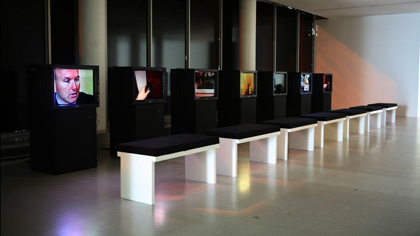
Hotel Diaries (2001-07) Photo: Lauren Winsor
Were you surprised to find yourself so happy with a gallery installation of all this work? Did you used to fight against that world more?
I’ve been showing quite a lot in galleries for about 15 years now – generally in group shows, but I’ve done six or seven one-person shows. Originally I saw it as a compromise – how do I get things as close as possible to a cinema? Whereas nowadays I feel as though a lot of the work really benefits from being show in this way. I guess what’s most important is to acknowledge the needs of individual works. So at the RCA, Slow Glass and The Black Tower are showing in a cinema environment, with advertised screening times, and a countdown between pieces so that between screenings you don’t think it’s broken down. And did you notice that the Hotel Diaries pieces can be restarted by the viewer? Nobody notices! That’s the one thing I’m disappointed by – the button is very discreet.
In Regression you make some barbed points about commodified art and limited-edition movies. What do feel now about file trading and digital exchange?
I feel really fine about it; disseminate as much as possible, basically. But my attitude to that has completely changed over the years. I remember when the ICA approached the London Film-makers’ Co-op to put lots of our work into its old videotheque library, offering 10p or something every time somebody watches a film, and we unanimously said “No way, our work has to be shown on film, and you’ve got to pay a rental fee if anyone wants to see the film.”
Then in, I guess, the mid 1990s I did some VHS tapes with the old London Electronic Arts: two anthology tapes for £20, and it was 20 years of my work, so a quid a year! At the time I thought, I’m probably going to lose some rentals, which no doubt I did, but so many more people got to know my work, and even if I’d been giving those tapes away they would have had rewards in terms of other opportunities and screenings. And people now only really hire film work if it’s going to be installed in a gallery; I think educational institutions have all got bootleg VHSs and DVDs. And I show other artists’ work the same way myself.
And in terms of the “shit that gets talked about the differences between film and video”, what work were you not happy to put on VHS?
Well, the pieces that you see on film at the RCA. Quite a lot of my early work was to do with the materiality of film, so Leading Light, Hackney Marshes – they’re both edited in camera, both have flash frames when the camera starts up... somehow I can’t bear to look at a flash frame on video. Whereas the majority of my work has got nothing to do with that; it’s to do with the language of film, but not the materials. So The Girl Chewing Gun, The Black Tower, Slow Glass – I’m now happier to show lots of those films on video, because you can get very decent video projectors now, prints don’t wear out, and you can send tapes all over the world for only a few quid and not worry about risking your print with an unsure festival.
The one compromise at this show is that Double Shutter is in a way a film idea, to do with the strobing of the shutter, but I also wanted to show it big, and you wouldn’t get a 16mm projector that was bright enough to show it on that scale. Anyway, the RCA couldn’t afford to get prints made of that piece as well, so the decision was made for us. But otherwise there’s an integrity about what’s showing on film and what on video.
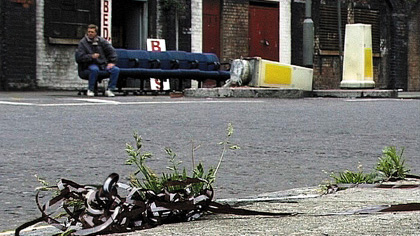
Lost Sound (2001)
Lost Sound brings us to audiotape, and back to your documentary side. It also reminds me of Agnès Varda and her gleaners.
The Gleaners & I? Yeah, I like that very much, it’s a fantastic piece. But finding subject-matter close to home has always been very important to me. Actually Graeme Miller and I – we collaborated on Lost Sound – are redoing an installation version, which involves finding a piece of tape in the street and projecting it onto two sides of a screen, so the A-side and the B-side of the tape. The rule is basically to take a walk from the gallery where the work’s going to be shown in a spiral until you find a piece of audio tape, and that piece becomes the subject of the work. And however long it is, that’s the duration of the shot that’s looped and repeated. I’m still a sucker for structuralist ideas!
People are asking us: Do you think you’ll find any tape? And it’ll be quite interesting if we don’t, because we’ve got to perform the piece that night. So we’re getting up early in the morning, and there’s a writer who’s going to document our travels. But I suspect we probably will find the tape, because if you look for things you find them. That’s the kind of philosophy that runs through a lot of my work.
Nothing in any of my films is researched; I come across things. Flag Mountain is literally the view from an apartment that I accidentally ended up staying in in Nicosia in 2007. I went back last summer, booked the same apartment and shot the film. And similarly Worst Case Scenario – that’s shot from a hotel room that they put me in for the Viennale. Two years later I phoned the hotel, said I really want to stay in the same grubby room – they thought I was a bit crazy – and barricaded myself in for a week with a camera pointing out the window.
There’s the wonderful quote in the catalogue that “a literal reading of all your films’ narratives would lead one to presume that you’re an alcoholic with mental health problems.”
Yeah, my wife laughed at that.
But maybe it’s the world that turns one into an alcoholic with mental health problems?
Well, I did have a bottle of wine last night…
‘Flag Mountain’ screens in competition at the Oberhausen Film Festival in May. John Smith Solo Show is documented on its dedicated website.
See also
The deathly hallows: Matt Collishaw on his Retrospectre homage to Sergei Parajanov (March 2010)
The man who wasn’t there: Morgan Fisher on his site-specific, ‘irrational’ cinema (February 2010)
Family photos: Sukhdev Sandhu on John Akomfrah’s Mnemosyne cine-essay on memory and migration (January 2010)
Project me: Isabel Stevens on the Jarman Award artists who straddle the worlds of gallery and screen (November 2009)
